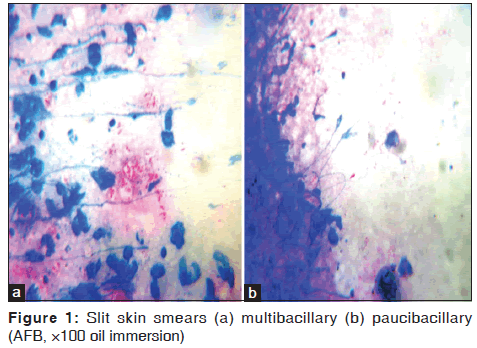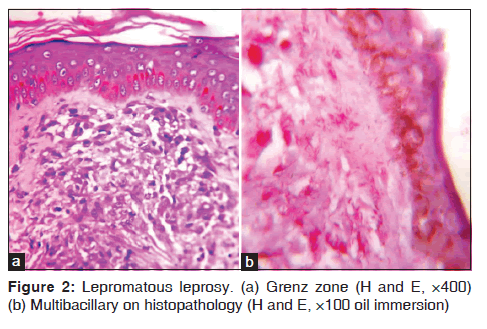Utility of Bacillary Index in Slit Skin Smears in Correlation with Clinical and Histopathological Alterations in Hansen’s Disease: An Attempt to Revive a Simple Useful Procedure
- *Corresponding Author:
- Dr. Renuka IV
Department of Pathology, NRI Medical College, Mangalagiri, Guntur-522 503, Andhra Pradesh, India.
E-mail: repriya56@gmail.com
Citation: Premalatha P, Renuka IV, Meghana A, Devi SI, Charyulu P, Sampoorna G. Utility of bacillary index in slit skin smears in correlation with clinical and histopathological alterations in hansen's disease: An attempt to revive a simple useful procedure. Ann Med Health Sci Res 2016; 6:181-4.
This is an open access article distributed under the terms of the Creative Commons Attribution-NonCommercial-ShareAlike 3.0 License, which allows others to remix, tweak, and build upon the work non-commercially, as long as the author is credited and the new creations are licensed under the identical terms.
Abstract
Leprosy, a relatively common chronic contagious disease having diverse modes of clinical presentation, can mimic a variety of unrelated diseases. For proper and adequate treatment, the diagnosis must be made accurately with subtyping which should be done with the help of bacillary index, histopathological features, and clinical correlation. This is extremely important in patient care as paucibacillary and multibacillary types have different modes of treatment. Our aim is to categorize leprosy into various types based on bacillary index, morphological findings both in slit skin smears, and biopsy along with clinical correlation
Keywords
Bacillary index, Histopathology, Leprosy, Multibacillary, Paucibacillary, Slit skin smears
Introduction
Leprosy is one of the leading causes of physical disabilities, contributing to intense social stigma resulting in human discrimination. This chronic infectious disease caused by Mycobacterium leprae not only affects skin and peripheral nerves but also involves muscles, eyes, bones, testis, and internal organs.[1]
Leprosy is a disease bedeviled by many classifications throughout history – Madrid classification (ILC 1953), Ridley and Jopling classification (1966), and Indian classification (IAL 1982). The standard research classification follows that of Ridley and Jopling which is based on immunopathological data.
At one end of the spectrum is polar tuberculoid leprosy (TT) which manifests with one or a few lesions with a paucity of organisms in them. At the other end is polar lepromatous leprosy (LL) in which numerous lesions with myriad bacilli are seen due to the absence of cellular immune response. In between these poles are borderline tuberculoid (BT), borderline-LL (BL), and mid-borderline (BB).
Subjects and Methods
The data of all leprosy skin lesions recorded in the Department of Pathology during January 2011 to July 2014 were taken for the study. Skin biopsies and slit skin smears were taken by a dermatologist in the outpatient department.
Slit skin smears had been taken from anyone with skin lesions which were considered as possibly due to multibacillary leprosy. Two smears were usually taken from the earlobes and two from the lesion(s) and examined.
Slit skin smears were stained in the Dermatology Department and skin biopsies were processed, sectioned, and stained with hematoxylin and eosin (H and E) in the Pathology Department. Acid-fast bacilli (AFB) (modified Fite-Faraco stain) was done simultaneously for all cases and classified as multibacillary and paucibacillary both in slit skin smears and histopathology [Figures 1 and 2].
Ethical approval was obtained for the manuscript from the Institutional Ethics Committee.
Results
Thirty cases were taken where slit skin smears were done. Nine of these were LL type, 8 BB type, 6 BT type, 4 TT type, 2 BL type, and one case of histoid type.
Regarding sex incidence, patients’ age ranged from 9 to 80 years. Twenty three patients were between second and fifth decade. There were 26 males and 4 females with male-female ratio, i.e., 6.5:1.
Bacillary indices were done. Nine paucibacillary cases and 21 multibacillary cases were identified through slit skin smears [Table 1]. Multibacillary lesions were lepromatous and histoid leprosy types.
| Type | No. | Paucibacillary | Multibacillary | |||||
|---|---|---|---|---|---|---|---|---|
| 0 | 1+ | 2+ | 3+ | 4+ | 5+ | 6+ | ||
| TT | 4 | 4 (100%) | 0 | 0 | 0 | 0 | ||
| BT | 6 | 5 (83.3%) | 1 (16.6%) | 0 | 0 | 0 | ||
| BB | 8 | 0 | 7 (87.5%) | 1 (12.5%) | 0 | 0 | ||
| BL | 2 | 0 | 0 | 0 | 1 (50%) | 1 (50%) | ||
| LL | 9 | 0 | 0 | 0 | 0 | 4 (44.4%) | 4 (44.4%) | 1 (11.2%) |
| HL | 1 | 0 | 0 | 0 | 0 | 1 (100%) | ||
*Statistically significant, EBP: Evidence-based practice
Table 1: Bacillary index in slit skin smears.
Among the thirty patients, only two cases were negative for slit skin smear and had bacilli detected in skin biopsies. Both were paucibacillary type [Table 1].
The highest clinicopathological correlation was seen in histoid leprosy (100%), followed by borderline (80%), LL (75%), borderline leprosy (71.4%), polar TT (66.6%), and the least correlation was seen in BT (50%).
The correlation between slit skin smears and histopathology was done [Table 2]. TT, BT, and BB types did not correlate well and percentage of diagnosis was the lowest for tuberculoid type (0%), followed by BT (66.6%) and BB (62.5%) types.
| Types of leprosy | Slit skin smears (%) | HPE |
|---|---|---|
| TT (4) | 0 (0) | 4 |
| BT (6) | 4 (66.6) | 6 |
| BB (8) | 5 (62.5) | 8 |
| BL (2) | 2 (100) | 2 |
| LL (9) | 8 (88.8) | 9 |
| HL (1) | 1 (100) | 1 |
| Total | 20 (66.6) | 30 |
HPE: Histopathological examination
Table 2: Slit skin smears and histopathological correlation.
In BL and HL types, the diagnosis made on slit skin smears correlated 100% with the histopathological diagnosis whereas LL type only 88.8% correlated with histopathology.
AFB positivity was seen in 22 cases with all nine cases of LL showing positivity (100%).
Discussion
Leprosy is a slowly progressive infection caused by M. leprae, affecting the skin and peripheral nerves. Histopathological examination of skin lesions is the gold standard for accurate diagnosis.[1,2] However, our aim is to revive the age-old practice of slit skin smears, which is done in the outpatient department itself and can be correlated with the histopathological diagnosis. This was found to be extremely useful in our study, especially in BL and HL types. The small sample of our study is because slit skin smears are rarely being done now, and hence, our aim is to revive this diagnostic method.
Leprosy can occur at all ages. In the present study, patients of 20–29 years old (third decade) were affected the most and patients below 9 years were affected the least. Similar observations were made by Guha et al.,[3] Kaur et al.,[4] Sehgal et al.,[5] Murthy,[6] and Kaur et al.[7]
Generally, leprosy is believed to be more common in males.[5,6] The present study also showed concurrence with the ratio of 5:1 indicating the same.
This was also observed in the studies by Sehgal et al.[5] and Murthy.[6] Male predominance may be because of many factors such as industrialization, urbanization, and more opportunities for contact in males.
In the present study, bacillary index was highest in HL followed by LL and low in BT. Jopling and McDougall [1] also observed that the bacilli are scanty or absent in BT, always present in BB, and numerous in BL, LL, and HL. The morphological index is better identified and appreciated in slit skin smears.
In most of our paucibacillary cases, the mean BI was higher in the skin biopsies than in the smears. The probability of finding bacilli in a patient is greater in the skin biopsies than in the slit skin smears. The reason suggested by Ridley was that bacteria in PB disease are more common in the deeper tissue (particularly nerves) than in the superficial dermal strata and thus are likely to be missed in slit skin smears.[7]
Correlation of AFB staining (bacillary index and morphological index) with H and E staining was 100% in HL, LL, and BL.
On histopathological examination, in most of the biopsies (56.6%), epidermis was atrophic and other epidermal changes were minimal.
In features of dermis, grenz zone, foamy or nonfoamy macrophages, periappendageal lymphohistiocytes, perineural lymphocytes, perivascular lymphohistiocytes, giant cells epithelioid granulomas, perineural lymphocytes, and perivascular lymphocytes were noted and typing was done accordingly.
The most commonly encountered type of leprosy was lepromatous followed by BB, BT, and TT. BL and HL were the least commonly encountered types.
Borderline group constituted the major spectrum (53.3%), similar to the findings of other authors such as Murthy,[6] Verma,[8] Shenoi et al.,[9] and Kumar et al.[10] Immunological instability in these borderline cases makes them move in either direction along the borderline spectrum. With treatment, they move toward tuberculoid pole (upgrading), and without treatment or lowered immune status, they move toward lepromatous pole (downgrading).
In our study, the correlation between slit skin smears and histopathology was not satisfactory for TT, BT, and BB types. However, in BL and HL types, the diagnosis made on slit skin smears correlated 100% with the histopathological diagnosis whereas LL type only 88.8% correlated with histopathology.
Both paucibacillary and multibacillary types of leprosy were followed up and showed good response to chemotherapy.
Conclusion
For accurate diagnosis and treatment, correlation of clinical, cytological, and histopathological features along with bacillary index for treatment response appears to be more useful than considering any of single parameter. Correlation between slit skin smears and histopathology was excellent in BL and HL types of leprosy and good with LL type. Hence, slit skin smear study would be useful when these types are considered clinically.
Financial support and sponsorship
Nil.
Conflicts of interest
There are no conflicts of interest.
References
- Jopling WH, McDougall AC. The disease. In: Handbook of Leprosy. 5th ed. Delhi: CBS publishers;1996. p. 10-53.
- Suri Sushilkumar K, Iyer Rekha R, Patel Darshana U, Supriya B,Seema B. Histopathology and clinico-histopathological correlation in Hansens disease. J Res Med Den Sci 2014;2:37-44.
- Guha PK, Pandey SS, Singh G, Kaur P. Age of onset of leprosy.Lepr India 1981;53:83-7.
- Kaur S, Kumar B, Roy SN. Endemicity of leprosy in the Union Territory of Chandigarh and surrounding states. Lepr India 1982;54:428-40.
- Sehgal VN, Ghorpade A, Saha K. Urban leprosy ? An appraisal from northern India. Lepr Rev 1984;55:159-66.
- Murthy N. Histopathological Study of Leprosy (Unpublished Doctoral Dissertation) Rajiv Gandhi University of Health Sciences; 2000. p. 17.
- Kaur I, Indira D, Dogra S, Sharma VK, Das A, Kumar B. ?Relatively spared zones? in leprosy: A clinicopathological study of 500 patients. Int J Lepr Other Mycobact Dis 2003;71:227-30.
- Verma OP. Some epidemiological features of leprosy in a rural area in Hooghly district. Lepr India 1976;48:371-81.
- Shenoi SD, Siddappa K. Correlation of clinical and histopathologic features in untreated macular lesions of leprosy ? a study of 100 cases. Indian J Lepr 1988;60:202-6.
- Kumar SK, Reddy BS, Ratnakar C. Correlation of skin and nerve histopathology in leprosy. Lepr Rev 1996;67:119-25.






 The Annals of Medical and Health Sciences Research is a monthly multidisciplinary medical journal.
The Annals of Medical and Health Sciences Research is a monthly multidisciplinary medical journal.